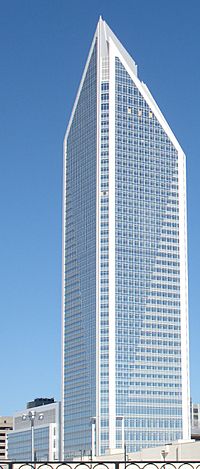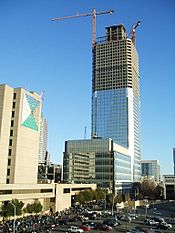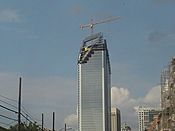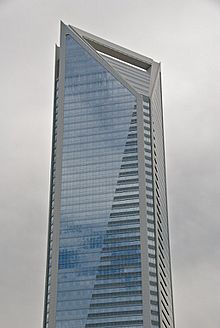Duke Energy Center facts for kids
Quick facts for kids Duke Energy Center |
|
|---|---|
 |
|
| General information | |
| Status | Complete |
| Type | Office |
| Location | 550 South Tryon Street Charlotte, NC |
| Coordinates | 35°13′26.48″N 80°50′53.28″W / 35.2240222°N 80.8481333°W |
| Construction started | February 28, 2006 |
| Opening | January 2010 |
| Cost | $880 million |
| Owner | Wells Fargo |
| Height | |
| Roof | 786 ft (240 m) |
| Technical details | |
| Floor count | 48 floors (54 in total with mechanical floors) |
| Floor area | 1,558,883 sq ft (144,825.0 m2) |
| Design and construction | |
| Architect | tvsdesign |
| Structural engineer | TRC Worldwide Engineering, Inc. |
| Main contractor | Batson-Cook Company subcontractors: Boda Plumbing, Inc.; J Davis Contracting Juba Aluminum Products Co., Inc. |
The Duke Energy Center is a 786-foot (240 m) tall, 48-floor (54 floors including mechanical floors) skyscraper in Charlotte, North Carolina. When completed in 2010, it was the largest building in Charlotte (in square footage), second tallest building in Charlotte, 63rd tallest building in the United States, and the tallest in the world to use precast double tees. The building is named for its anchor tenant, Duke Energy, and both the tower and the adjacent cultural arts campus are owned by Wells Fargo.
Sonnenschein will use 35,000 square feet (3,300 m2) on the 34th and 35th floors and Deloitte will use 82,000 square feet (7,600 m2).
Originally, the building was to be known as the Wachovia Corporate Center. It was to replace One Wachovia Center as the headquarters of Wachovia. Wachovia was to occupy 450,000 square feet (42,000 m2) of the 1.5 million square feet (140,000 m2) tower. Wells Fargo, which took over Wachovia December 31, 2008, planned to use five of its 14 floors.
Contents
Construction

The project was announced in the spring of 2004, and official renderings were not released until December 6, 2006. In the original petition to the Charlotte-Mecklenburg Planning Commission, the building was going to be built on a 1.29-acre (5,200 m2) parcel next to 400 South Tryon, with a height of 510 feet (160 m) and 34 floors. The site preparation began with the demolition of a Firestone Tire dealership in February 2006, and on February 28, 2006, the excavation and blasting of a 100-foot (30 m)-deep hole for the below-grade parking garage began. Over 600,000 pounds (270,000 kg) of explosives were used during its excavation and it took just over 60,000 dump truck loads to remove all of the excavated material from the site, some of which was used in the construction of a third runway at Charlotte-Douglas International Airport.
The building was constructed by Batson-Cook Construction, with ready mix products from Concrete Supply Co. and structural engineering firm TRC International Ltd, of Sarasota, Florida. The building core is constructed with poured-in-place concrete while the floor structures utilize precast double tees, a structural method typically seen in parking decks. These double tees span between the poured-in-place core and perimeter systems. The concrete used for the building is 18,000 pounds per square inch (120,000 kPa).
The building received a certificate of occupancy on December 23, 2009, with the lobby and parking garage opening on January 2, 2010.
Features
It is the tallest building in the Levine Center for the Arts (formerly the Wells Fargo Cultural Campus) and the largest building in Charlotte, which will have a 250,000-square-foot (23,000 m2) footprint. The complex will also include a 46-floor condominium tower (future), the Harvey B. Gantt Center for African-American Arts + Culture, the Mint Museum Uptown, the Knight Theater, the Bechtler Museum of Modern Art, and a History Museum. The building has achieved LEED Platinum status by including water-saving plumbing devices, a water storage system that will treat rainwater to be used for cooling tower make-up water, and a green roof. Rock that was blasted for the parking structure is being recycled by hauling it to a local quarry, where it will be crushed for gravel.
The facade of the structure is illuminated by hundreds of programmable color-changing LED and metal halide luminaires with design work by Gabler-Youngston Architectural Lighting Design. The facade lighting system provides various shows and effects. Highly visible over the east corner of Bank of America Stadium, the lighting show is used during key moments of sporting events played there. For example, if the Carolina Panthers are playing, it lights up blue for Panthers touchdowns. During the ACC Championship Game, whenever a team scores a touchdown, it lights up in that team's color.
Retail tenants
In 2011, the Duke Energy Center welcomed several new retail tenants to the building, offering suite spaces on the ground level for restaurants and markets.
Original plans for Wachovia use
Duke Power chief executive Bill Lee had put together the property in the 1990s, intending to build Duke's headquarters there, but the company dropped its plans and sold the land to Wachovia.
The first floor of the building was to contain the main lobby and elevators. The second floor was to have Wachovia's server room. The third floor would have been occupied by training areas during the day and classrooms at night. This area was to have been shared by Wachovia and Wake Forest University, which was to use it for its MBA courses. Floors four through seven were to contain the trading floor. It would have taken up 45,000 square feet (4,200 m2) and housed approximately 750 traders per floor. Wachovia would also have used floors 36 through 48. After Wells Fargo announced its purchase of Wachovia, Duke (by this time called Duke Energy) more than doubled the space it planned to use from 240,000 square feet (22,000 m2) to 500,000 square feet (46,000 m2) and the name changed to Duke Energy Center. In addition to the upper floors Wachovia would have used, Duke planned to use floors 15 through 22. Wells Fargo, which still owned the building, planned to occupy five of its 14 floors late in 2010. KPMG and Katten Muchin Rosenman moved into the building in February 2010, while Duke Energy moved later in 2010.
Original plans for Wake Forest University
Originally, Wake Forest University had planned to locate the Charlotte campus of its Babcock Graduate School of Management in the tower, occupying approximately 25,000 square feet (2,300 m2). However, Wake Forest pulled out of the project after the purchase of Wachovia by Wells Fargo.
Images for kids
See also
 In Spanish: Duke Energy Center para niños
In Spanish: Duke Energy Center para niños




